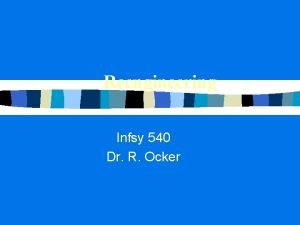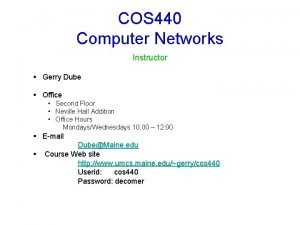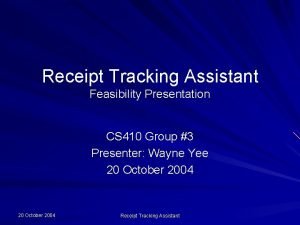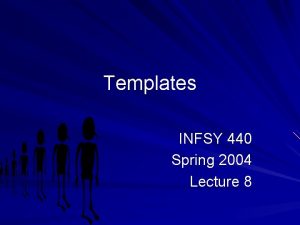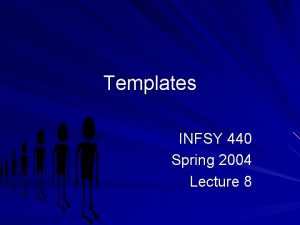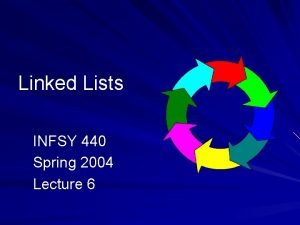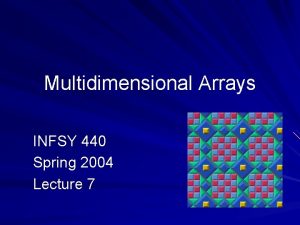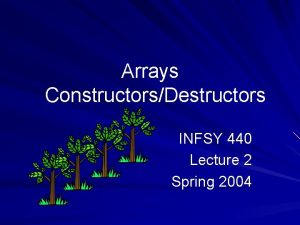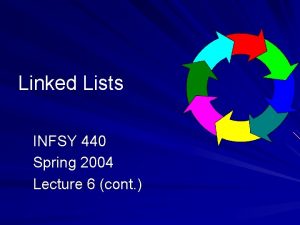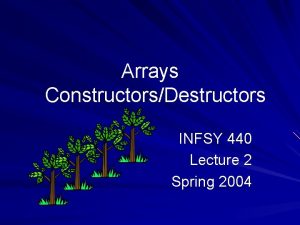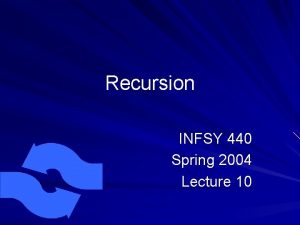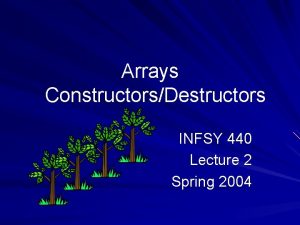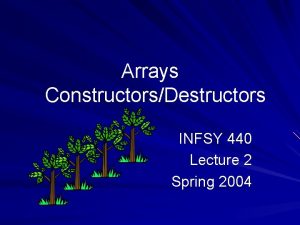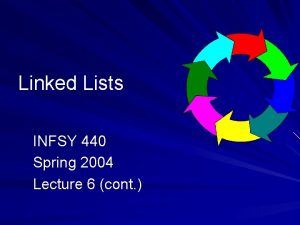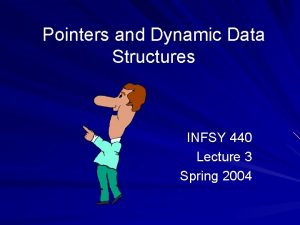Templates INFSY 440 Spring 2004 Lecture 8 Templates


















- Slides: 18

Templates INFSY 440 Spring 2004 Lecture 8

Templates Functions are written to match a specific algorithm. – What if they could be written to be more generic? – Could reduce amount of coding needed!

Templates Mechanism for generating functions and classes based on generic data type. – templates are sometimes called "parameterized types" By using templates, you can design a single function or class that operates on data of many types, instead of having to create a separate function or class for each type.

Templates Function Overloading: void swap_values (int& var 1, int& var 2); void swap_values (char& var 1, char& var 2); void swap_values (double& var 1, double& var 2);

Templates void swap_values (int& var 1, int& var 2) { int temp; temp = var 1; var 1 = var 2; var 2 = temp; }

Templates void swap_values (char& var 1, char& var 2) { char temp; temp = var 1; var 1 = var 2; var 2 = temp; }

Templates void swap_values (double& var 1, double& var 2) { double temp; temp = var 1; var 1 = var 2; var 2 = temp; }

Function Template prefix: – tells the compiler that the definition or prototype that follows is a template, – and the variable is a type parameter template<class T> NOTE: word class actually means type.

Function Template template<class T> void swap_values (T& var 1, T& var 2) { T temp; temp = var 1; var 1 = var 2; var 2 = temp; }

Function Template Function Call: int var 1 = 9, var 2 = 4; swap_values(var 1, var 2); char symbol 1 = ‘a’, symbol 2 = ‘z’; swap_values(symbol 1, symbol 2);

How to Define Templates 1 Write a version of a function normally. 2 Completely debug the ordinary function. 3 Then convert the ordinary function to a template by replacing some data type names with a type parameter.

Let’s Practice! Create a project with one file – main. cpp Write a function to square an int number Write main. cpp to prompt a user to enter an int number and call the function to generate it’s square Change it to a template function and try is with an int and a double number

Algorithm Abstraction Express an algorithm in a very general way so that we can ignore incidental detail and concentrate on the substantive part of the algorithm. Function templates are one feature of C++ that supports algorithm abstraction.

Class Templates Start with template prefix template<class T> class Pair { public: ……. – “T” is the traditional type parameter

Class Templates Member Function template<class T> void Pair<T>: : set_element(int position, T value) { if (position == 1) first = value; else if (position == 2) ……. . }

Class Templates Declare objects of the class int main( ) { Pair<int> score; Pair<char> seats; ……. score. set_element(1, 2);

Let’s Practice Write a program to compute the area of a rectangle using the member variables and functions shown in the UML diagram on the next slide. When the program works, change it to a template class so it will accept any type of numeric input.

Let’s Practice Where: – Area = width * length
 Dr ocker
Dr ocker 01:640:244 lecture notes - lecture 15: plat, idah, farad
01:640:244 lecture notes - lecture 15: plat, idah, farad Autumn is yellow winter is white
Autumn is yellow winter is white Four seasons korean movie
Four seasons korean movie 25-3/440
25-3/440 Salmovac 440 vaccine
Salmovac 440 vaccine Frm handbook
Frm handbook Cos440
Cos440 Pimer monitor
Pimer monitor Ai 440
Ai 440 Area code 440 location
Area code 440 location Ensc 440
Ensc 440 Xenotest 440
Xenotest 440 Fin 440
Fin 440 Bola dengan massa 0 440 kg yang bergerak ke timur
Bola dengan massa 0 440 kg yang bergerak ke timur Polylite 440-m850
Polylite 440-m850 Lesson 17: patterns and processes of evolution
Lesson 17: patterns and processes of evolution Bola dengan massa 0 440 kg yang bergerak ke timur
Bola dengan massa 0 440 kg yang bergerak ke timur Ffsst
Ffsst
